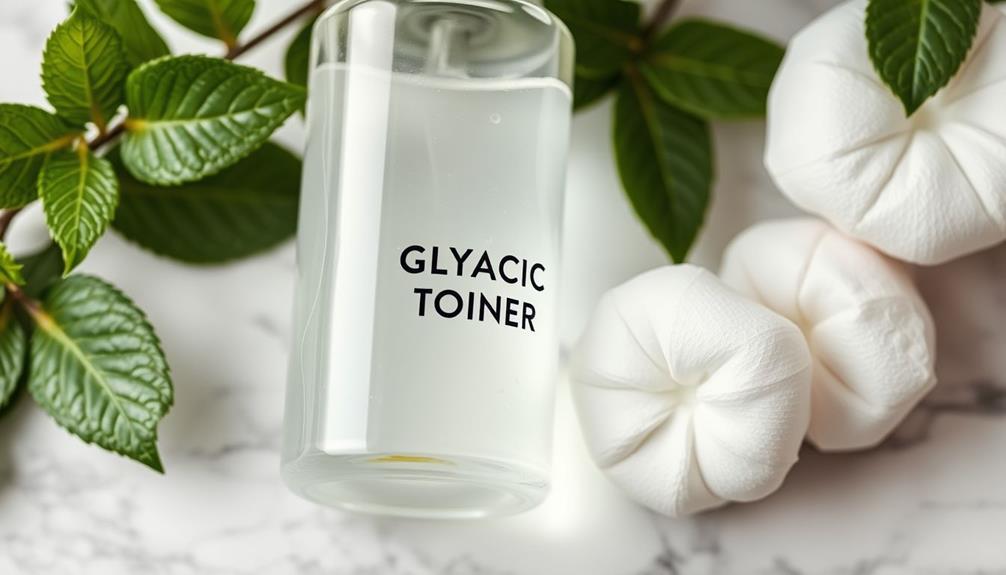Glycolic acid is effective in reducing dark pigmentation and enhancing the texture of your armpits by exfoliating dead skin cells and encouraging cell turnover. This alpha-hydroxy acid penetrates deep into the skin, breaking down the bonds between skin cells and revealing a brighter tone underneath. Consistent use can address thickened skin and prevent the buildup of products, which are common causes of darkness. You can expect to see visible improvements in just 4-6 weeks. Remember to do a patch test and start with lower concentrations. By using the correct approach, you can achieve smoother, lighter underarms. Discover the products and techniques that can further improve your results.
Key Takeaways
- Glycolic acid exfoliates dead skin cells, revealing brighter and more even-toned underarm skin.
- It reduces hyperpigmentation, addressing the darkening often seen in armpits.
- Regular use promotes skin cell turnover, enhancing skin texture and elasticity.
- Consistent application can lead to noticeable lightening results in 4-6 weeks.
What Is Glycolic Acid?
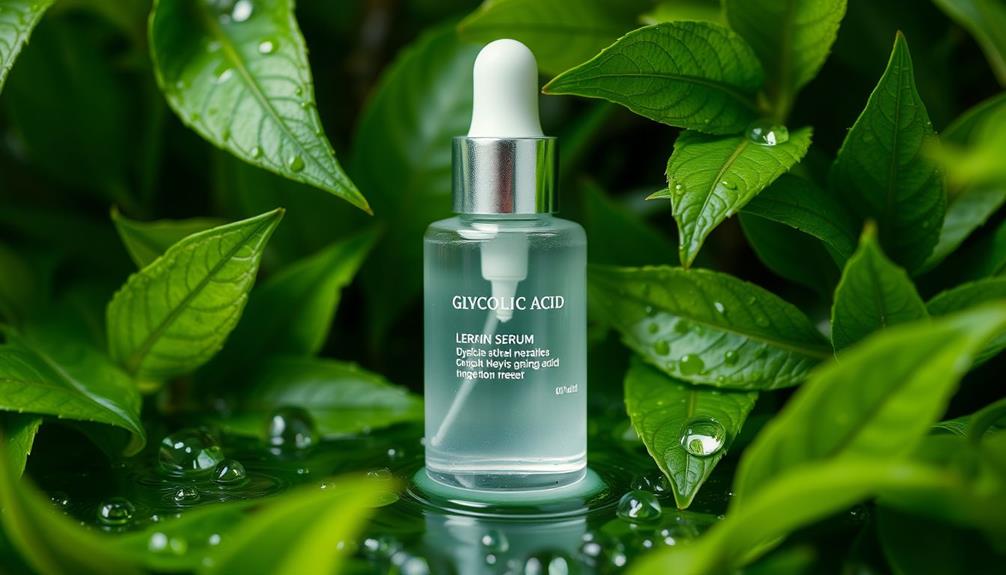
Glycolic acid, a powerful alpha-hydroxy acid derived from sugar cane, effectively exfoliates the skin by removing dead cells and promoting a brighter, smoother appearance.
With its small molecular size, glycolic acid penetrates deeply, making it a favorite in skin care products. Its exfoliating properties help to break down the bonds between dead skin cells on the surface, allowing for easier removal and revealing fresh, new skin underneath.
Additionally, essential oils can enhance skin health by providing soothing properties during the exfoliation process.
Regular use of glycolic acid can greatly improve texture, making it an excellent choice for anyone struggling with uneven skin. It's particularly beneficial for areas like dark underarms, as it can help fade discoloration over time.
Additionally, this acid encourages collagen production, which is essential for maintaining skin elasticity and firmness.
Incorporating glycolic acid into your routine—whether through chemical peels, toners, or serums—can lead to healthier, more radiant skin.
Benefits for Dark Armpits
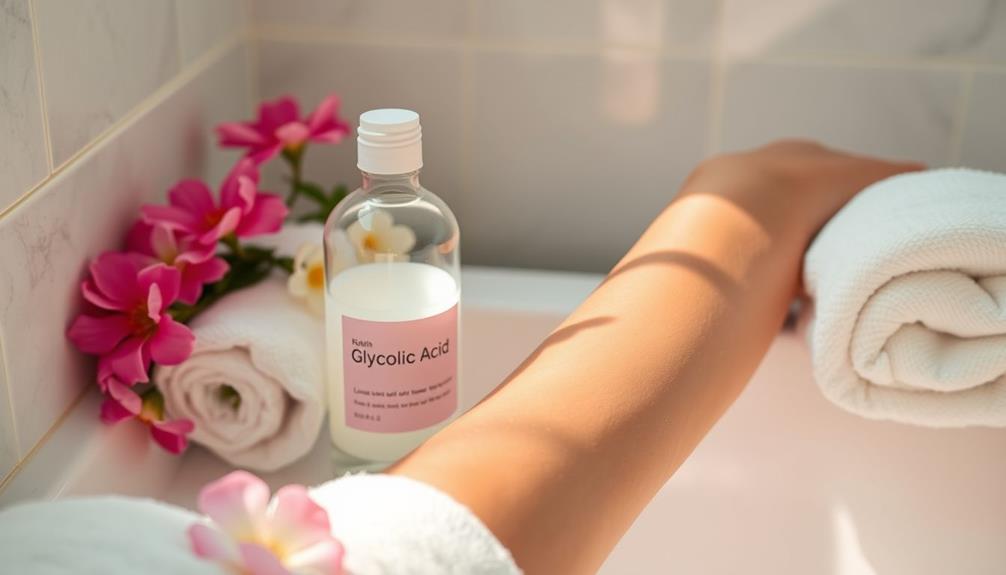
Effectively exfoliating the skin, glycolic acid reveals a brighter and more even tone in dark armpits. As one of the most popular exfoliating acids, it penetrates deeply due to its small molecular size. This deep penetration not only promotes cell turnover but also helps reduce hyperpigmentation associated with dark underarm skin.
Additionally, incorporating natural alternatives like essential oils for skin can complement your skincare routine, enhancing overall skin health. By regularly incorporating glycolic acid into your routine, you can considerably improve skin texture and clarity.
It addresses thickened skin and product buildup, two common contributors to darkness in the underarm area. Studies show that consistent application can lead to noticeable lightening of pigmentation in just four to six weeks, enhancing your skin's overall appearance.
Moreover, glycolic acid isn't just about lightening; it also prevents ingrown hairs, which can be an issue in this sensitive area. With its smoothing properties, it helps create a more refined and polished look for your underarms.
Embracing glycolic acid can transform your dark armpits, leaving you feeling more confident and comfortable in your skin. So why not give it a try? You'll likely see the benefits in no time.
How to Apply Glycolic Acid
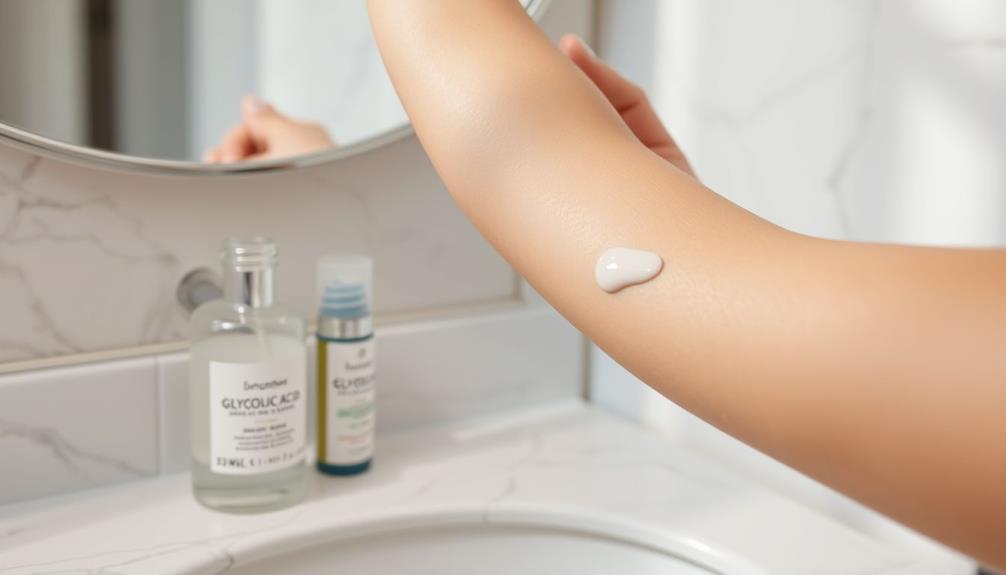
To achieve the best results with glycolic acid, it's important to know how to apply it properly to your underarms. Start with clean, dry armpits and use a cotton pad to apply a thin layer of a glycolic acid product, such as The Ordinary Glycolic Acid 7% Toning Solution. Guarantee you cover the underarm skin evenly.
Incorporating a consistent skincare routine can enhance the effectiveness of treatments like glycolic acid, as it helps maintain overall skin health, similar to how a calming bedtime routine improves sleep quality.
Here's a quick guide for applying glycolic acid:
- Conduct a patch test: Check a small area of skin for any adverse reactions, especially if you have sensitive skin.
- Limit application frequency: Start by applying glycolic acid once or twice a week, gradually increasing as your skin tolerates it.
Pre and Post Treatment Care
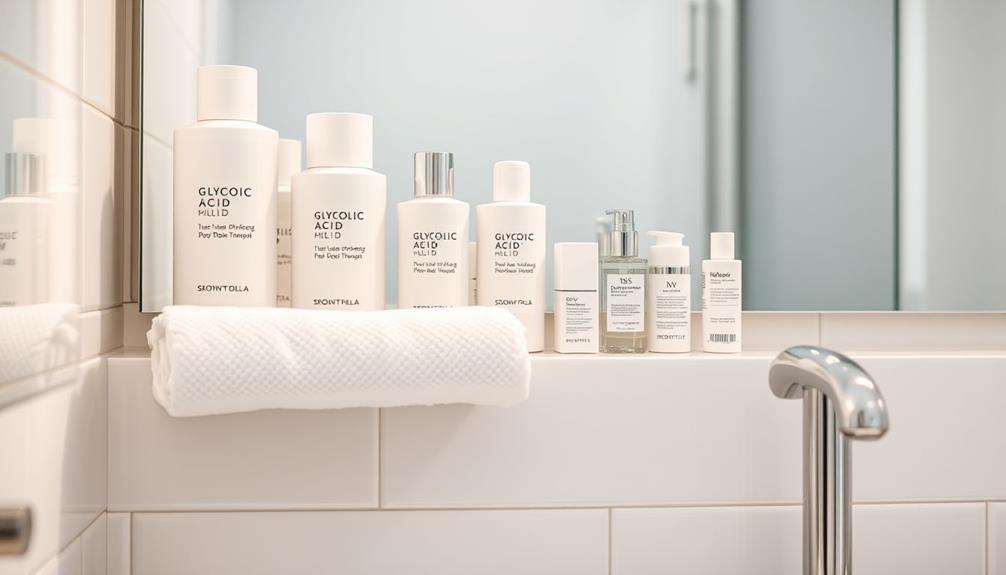
Before starting glycolic acid treatments, make sure your underarms are clean, dry, and free from any irritants to minimize the risk of adverse reactions.
It's essential to conduct a patch test on a small area to identify any potential irritation, especially if you have sensitive skin.
Begin with a lower concentration of glycolic acid, ideally under 10%, to help your skin acclimate gradually.
Additionally, understanding your skin's response can be enhanced by recognizing signs of irritation, similar to how cats exhibit behaviors indicating attachment to their owners.
For pre-treatment care, limit any harsh products in your routine, and consider applying glycolic acid only two to three times a week initially.
This approach can markedly reduce the likelihood of irritation based on your skin type.
Post-treatment care is equally important.
After applying glycolic acid, rinse the area gently with cool water and apply a gentle moisturizer to soothe and hydrate your skin.
Always remember to protect your treated skin from UV damage by using a broad-spectrum sunscreen during the day.
This helps prevent any adverse effects from sun exposure, ensuring you get the best results from your glycolic acid treatments while keeping your underarms healthy and radiant.
Recommended Products

When it comes to treating dark armpits with glycolic acid, choosing the right products is key.
Products containing glycolic acid can aid in exfoliating the skin, helping to remove dead skin cells and promote a more even skin tone.
You'll want to look for effective ingredients and know how to apply them properly for the best results.
For added benefits, consider incorporating juicing techniques that include antioxidant-rich ingredients to support skin health from the inside out.
Let's explore some top recommendations to help you brighten and smooth your underarm skin.
Top Glycolic Acid Products
Discover the best glycolic acid products that can help lighten dark armpits and enhance your skin's overall appearance. These products feature effective glycolic acid formulas designed specifically for the underarm area, targeting dark spots and improving skin texture. Maintaining joy in skincare routines can be essential, especially during challenging times, as it keeps the focus on self-care and well-being. For more insights on creative approaches to personal care, check out Tooth Fairy Pranks.
- The Ordinary Glycolic Acid 7% Toning Solution: This popular choice is known for its powerful exfoliating properties, helping to fade dark spots and rejuvenate your skin.
- Kosas Chemistry AHA Serum Deodorant: Combining glycolic acid with skin-soothing ingredients, this deodorant not only tackles body odor but also addresses ingrown hairs and dark pigmentation.
Additionally, consider Nécessaire The Deodorant Gel, which controls odor while being gentle on sensitive skin, or Surface Deep Anti-Odorant Pads, perfect for on-the-go freshness with the benefits of glycolic acid.
Incorporating these products into your routine can help you achieve brighter, smoother underarms while ensuring you smell great with natural deodorants.
Ingredients to Look For
To effectively brighten dark armpits, look for products that feature glycolic acid concentrations between 8-10% for ideal exfoliation and pigmentation reduction.
Glycolic acid, a type of alpha hydroxy acid, works wonders for dark underarm skin by sloughing off dead skin cells and promoting a more even tone. A highly recommended option is The Ordinary Glycolic Acid 7% Toning Solution, known for its consistent results in improving skin texture.
Additionally, consider exfoliating body scrubs, like Forgotten Skincare Get It Bright Exfoliating Body Scrub. These scrubs utilize glycolic acid to smoothen and brighten your skin effectively.
When selecting deodorants, look for those that combine glycolic acid with soothing ingredients, such as the Kosas Chemistry AHA Serum Deodorant. This product not only helps prevent body odor but also minimizes ingrown hairs, making it perfect for sensitive areas.
Don't forget to check for products that include hydrating components like ceramides and aloe vera, as these can enhance moisture retention and soothe irritation.
These ingredients create a balanced approach to skincare, ensuring your journey to brighter armpits is gentle and effective.
Application Tips and Techniques
Achieving brighter armpits requires careful application of glycolic acid products, guaranteeing you maximize their effectiveness while minimizing any potential irritation. Here are some essential application tips to help you get started:
- Start with a patch test: Before applying glycolic acid to your dry armpits, conduct a patch test on a small area of skin to check for irritation. This guarantees your skin can tolerate the product.
- Use a cotton pad: Apply the glycolic acid product, like The Ordinary Glycolic Acid 7% Toning Solution, using a cotton pad. This method guarantees even coverage and effective exfoliation.
Limit your initial use to once or twice a week, gradually increasing the frequency as your skin adjusts.
Always rinse with cool water after the recommended application time, and follow up with a gentle moisturizer.
Common Concerns
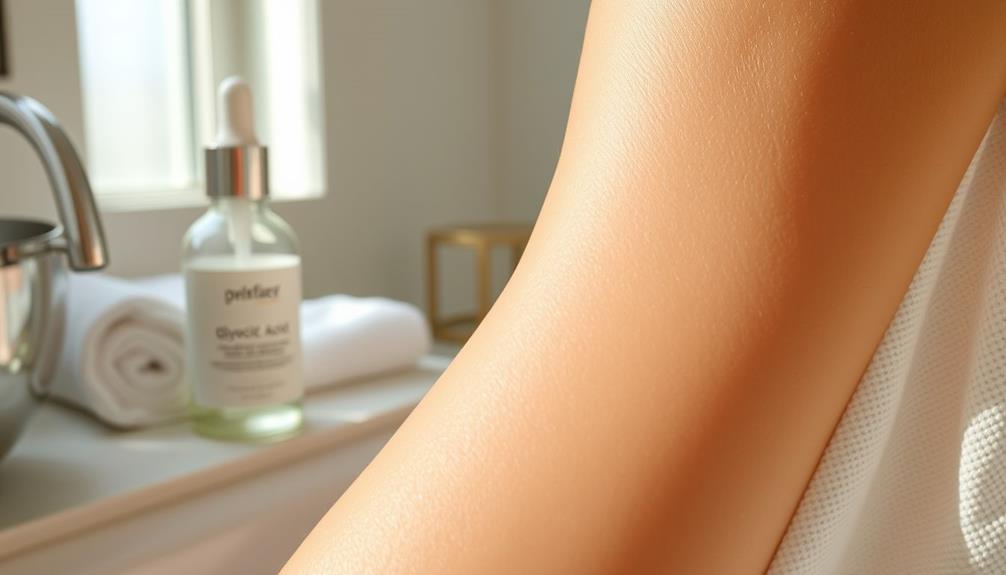
When using glycolic acid for dark armpits, you might've some common concerns about safety and effectiveness.
It's essential to take into account how your sensitive skin might react, the importance of patch testing, and what kind of results you can realistically expect.
Let's take a closer look at these key points to guarantee a safe and effective experience.
Safety for Sensitive Skin
Glycolic acid can be safe for sensitive skin in areas like the underarms if used correctly and with caution. To minimize the risk of irritation, consider the following tips:
- Patch test: Always perform a patch test on a small area of skin before applying glycolic acid to verify you don't have an adverse reaction, especially if you have sensitive skin.
- Limit application: Use glycolic acid only once or twice a week. Over-exfoliation can lead to increased sensitivity and irritation.
It's crucial to avoid using glycolic acid alongside other irritants, such as retinol, as this can lead to compounded irritation and potential darkening of the treated area.
By following these guidelines, you can safely incorporate glycolic acid into your skincare routine, even for sensitive skin.
Expected Results Timeline
Users can expect to see gradual lightening of dark underarms within four to six weeks of consistent glycolic acid use, depending on individual skin type and product strength. Glycolic acid works primarily by exfoliating dead skin cells, which promotes skin cell turnover and helps create a more even skin tone over time.
The key to seeing results lies in regular application—aim for two to three times per week to balance effectiveness with minimal irritation. However, individual results may vary due to skin sensitivity and adherence to recommended practices. It's essential to monitor how your skin reacts to glycolic acid, as some might experience irritation, especially in sensitive areas like the underarms.
To maximize results and minimize adverse effects, consider using lower concentrations initially and gradually increasing strength as your skin adjusts.
Additionally, don't forget to incorporate daily SPF protection into your routine. This step is important to prevent UV-induced pigmentation and guarantee that the results you achieve with glycolic acid are long-lasting.
Patch Testing Importance
Introducing glycolic acid to your skincare routine can be exciting, but patch testing is an essential step to guarantee your skin reacts well before applying it to sensitive areas like your armpits.
This process helps identify any potential allergic reactions or sensitivities that could lead to unwanted skin irritation.
To conduct an effective patch test, follow these steps:
- Apply a small amount of glycolic acid on a discreet area, like your inner forearm.
- Wait 24 to 48 hours to observe any adverse effects, such as redness or burning.
User Experiences and Tips

Many people have shared their success stories with glycolic acid, noting significant improvements in the brightness and texture of their underarms within just a few weeks. User experiences highlight that consistent use of products like The Ordinary Glycolic Acid Toner can lead to noticeable results in about four to six weeks.
To minimize irritation, it's vital to start with a patch test to see how your skin reacts before applying it fully. Many users recommend applying glycolic acid at night, as this reduces sun sensitivity and enhances exfoliation. After applying, don't forget to moisturize to maintain skin hydration.
Some individuals have found that combining glycolic acid with brightening deodorants can boost your results, tackling both dark underarms and body odor effectively. However, it's important to avoid using glycolic acid alongside other potent ingredients, like retinol, to minimize the risk of irritation.
Following these tips can help you achieve the brighter, smoother underarms you desire while keeping your skin healthy and irritation-free. Embrace the journey, and don't hesitate to adjust your routine based on how your skin responds!
Frequently Asked Questions
Does Glycolic Acid Help With Dark Underarms?
Yes, glycolic acid helps with dark underarms. It exfoliates dead skin cells, promotes even skin tone, and boosts cell turnover, leading to noticeable lightening and healthier skin with regular use over a few weeks.
How Long Does It Take for Glycolic Acid to Work on Underarms?
Like a sunrise breaking through the darkness, you'll notice glycolic acid working its magic in four to six weeks. Consistent application brings gradual lightening, revealing brighter, smoother skin beneath, so patience is key.
How Do You Use Glycolic Acid 7% for Armpits?
To use glycolic acid 7% on your armpits, clean and dry the area first. Soak a cotton pad, swipe it gently over the skin, limit usage to 1-2 times weekly, and moisturize afterward.
What Are the Benefits of Glycolic Acid for Hyperpigmentation?
Imagine revealing your skin's true radiance. Glycolic acid tackles hyperpigmentation by exfoliating dead cells, promoting even skin tone, and boosting collagen. Regular use transforms your skin, making it brighter and healthier, revealing the beauty beneath.
Conclusion
Incorporating glycolic acid into your skincare routine can be a game-changer for dark armpits, much like finding that perfect shade of lipstick that transforms your look.
This powerful ingredient gently exfoliates, revealing brighter skin underneath.
Remember, patience is key—results won't appear overnight.
So, embrace this journey to confidence with open arms, and soon you'll be flaunting your fresh underarms like a red-carpet star.
Don't wait; start your transformation today!


